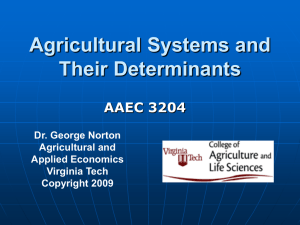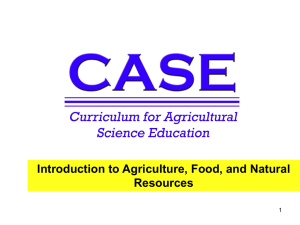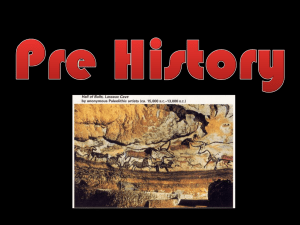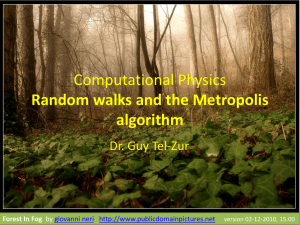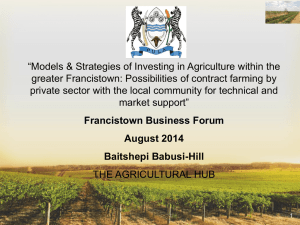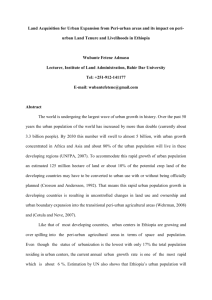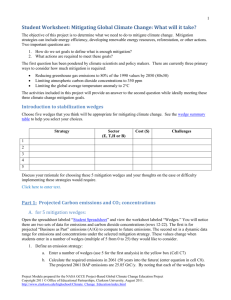Agriculture as a Sustainable Use of Urban Land
advertisement
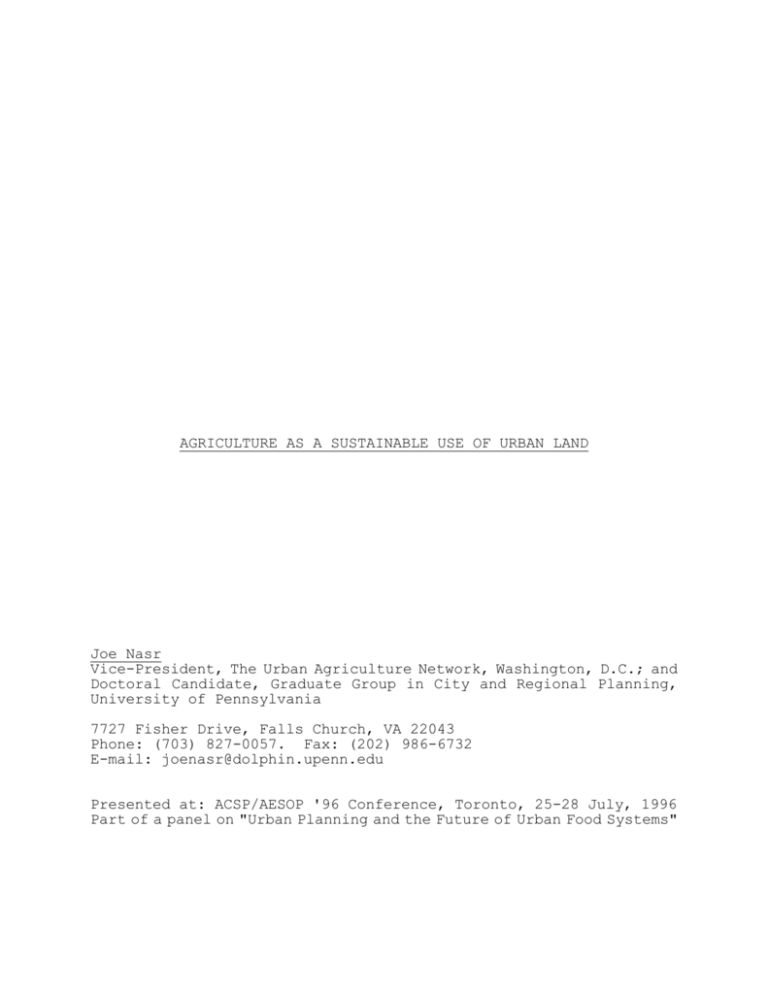
AGRICULTURE AS A SUSTAINABLE USE OF URBAN LAND Joe Nasr Vice-President, The Urban Agriculture Network, Washington, D.C.; and Doctoral Candidate, Graduate Group in City and Regional Planning, University of Pennsylvania 7727 Fisher Drive, Falls Church, VA 22043 Phone: (703) 827-0057. Fax: (202) 986-6732 E-mail: joenasr@dolphin.upenn.edu Presented at: ACSP/AESOP '96 Conference, Toronto, 25-28 July, 1996 Part of a panel on "Urban Planning and the Future of Urban Food Systems" Agriculture in urban areas is generally perceived by planners as a short-lived and marginal land use until urbanization takes over with "higher" land uses. Agricultural lands at the edges and within a metropolitan area are thus considered reserves of land awaiting development. This paper argues that this view of the place of agriculture within the patchwork of urban and periurban land uses that form the modern metropolis is both too limited and unsustainable. It also does not reflect the reality of where the food consumed by urban residents originates from in cities of industrial countries, and even more so in those of developing countries. To illuminate this alternative paradigm, a series of arguments will be made. The first argument is that, in a particular piece of land, agriculture may be temporary, yet it is also an unceasing activity. Some light will be shed here on this seeming oxymoron from a number of angles. First, as the leading edge of development pushes out, there are always zones where farming is interspersed with other land uses. So cities are never solidly built-up in their totality. We will see below a very long list of gaps in the built urban fabric, even where that fabric is tightly woven. Second, land that is built-upon today may be cleared tomorrow. This accounts for the emergence of the issue of so-called brownfields as a critical issue of urban management. Brownfields can best be defined as land that had been built and utilized productively but is no longer so. One of the prime reuses of these lands is for agricultural production, if only for an interim period. When cities end up with 16,000 vacant lots within their limits as Philadelphia does today, the placement gradually of some - as many as possible - of these lots into cultivation at least puts them into productive use. Even if many of these parcels are slowly converted into other uses, there is a seemingly endless supply of agricultural lands in inner cities today, especially in U.S. cities, as newly-vacant properties get added to the cities' stock just as some of the vacant ones are reclaimed. Third, a metropolitan area always has an edge. As the urbanized zones expand, the edge also expands. In fact, simple mathematical observation indicates that, if a metropolis is represented figuratively by a circle, the perimeter increases far more than the radius: for each additional mile that the "leading edge of development" stretches out from downtown, the length of the edge automatically increases by over six miles (2 x pi). Thus, not only is there always a peri-urban belt, but that belt is always growing faster than the city is expanding. That loosely-defined belt is invariably the site of a mixture of certain forms of agriculture and other uses. So as long as a city keeps growing, there are always some agricultural zones along its perimeter which are impressed with certain characteristic influences of the urban area in whose orbit they fall. Some conversion from rural to urban agricultural practices takes place naturally in these areas, but a variety of measures can assist in broadening this 1 timely conversion. Fourth, a metropolitan area is obviously not perfectly circular. Usually, its circumference is vaguely star-shaped. The classic concept of the wedges and corridors is useful here. This is not meant to imply that the tentacular model represents reality any more perfectly than the circular one. Moreover, this model is not used here as a principle that governs planning policies, as it had some decades ago. Rather, it is meant as a descriptive concept that is still relevant as it helps visualize a basic principle of how urban settlements develop: there are always some urban districts that are settled less densely than others. Within these precincts, which are often linearly patterned, one would find more spaces that are left open as well as more institutionally-owned properties that are only partly built-up. These wedges often develop along lands (and water bodies) that are harder to settle on. Lower-density axes are always growing as the city expands. Indeed, following the same arithmetic that was mentioned above, the wedges grow disproportionately to the radius of the urbanized area. Some of these wedges form part of the peri-urban zones, extending out into the countryside, while others are engulfed fully into the metropolis, becoming "islands of green" inside it. Even as some of the wedges get built up, newer ones sprout further out. Consequently, in any one spot within an urban area, agriculture may be a temporary use of land. In the same way, it may be an activity undertaken on a temporary basis by a particular individual. But the presence of the activity in some places, and by some individuals, within a metropolitan area is in fact continuous and sustained. There is constantly some land being used for farming which somehow managed to escape the building cycles, while other farmland had actually been used for building in a previous life. Moreover, there are always some cultivated peri-urban zones and wedges. Agriculture therefore needs to be regarded as a basic use of land in a metropolitan area. It should not be represented as asterisks within the built environment - it is a full-fledged member of that environment. The second argument that is made here is that, inside urban areas, there are typically considerable expanses of land that are available for food production on a variety of bases. The concept of "available" is however not as straightforward as it may appear. In the fourth chapter of our book (titled "Where is Agriculture Found in the City?"), we use four different ways of categorizing the geographic aspects of urban agriculture: 1the types of spaces being used; 2the duration of use; 3the location within a metropolitan area (core, corridors, wedges, periphery), as discussed above; and 4the means of access to land and tenure (ranging from the spontaneous squatting to the high-investment high-yield facility held and managed by a landowner, with a range of intermediate arrangements). 2 Corresponding to each of these categories are consequences on the role of agriculture, the type of crop grown, etc... Put together, it can give a sense of the different attributes that shape agriculture as an urban (and peri-urban) land use. The first two categories will be described further, as they give respectively spatial and temporal dimensions to the activity. Examples of urban lands and waters that are commonly available and suitable for agricultural uses include: backyards, rooftops, balconies and other spaces at the home; park lands and other dedicated open spaces within the community; steep slopes; wetlands, rivers, lakes, lagoons; roadsides, other rights-of-way (power lines, gas lines, railways, etc...); buffers at airports and industrial complexes; reserve lands for future expansion of industrial, residential, institutional and other precincts. Once all these and other sites are added up, a very extensive agricultural presence in the nooks and crannies of the urban environment emerges. In fact, "nooks and crannies" does not convey the scale of a land use that often makes up half or more of the land in a metropolitan area that is actively used by humans. It should be noted that the volume of nooks and crannies is actually growing even in the most heavily populated cities. The areal expansion of cities is increasing faster than their populations. This is most noticeable in the sprawling North American cities. For instance, whereas the population of greater Chicago grew by four percent in the 1980s, the urbanized area expanded by ten times that rate. Less known is that the same dedensification is occurring in cities worldwide, although more slowly. So while farmland is being lost at a rapid rate across the globe, the amount of urban farmland is increasing. In several East African capitals, for instance, the amount of cultivated land (in expanding municipalities) has doubled in the span of just a few years. This means that new land that is usable for urban agriculture is being created (out of formerly rural land) at a greater rate than the metropolitan population is increasing. It is important for urban planners and managers to account not only for which interstices are being utilized for farming, but also for how long they are placed in such a use, as this affects the way they would handle these spaces. It is most useful to approach the duration of agricultural use as consisting of three types of terms: permanent, long-term and short-term. The inclusion of a category of permanent agriculture points out that, while much urban agriculture may be temporary in nature (even if its presence lasts for many years in a particular place), there are also sites within every metropolis where farming is not only an adequate use, but also the most appropriate use indefinitely into the future. These sites may be in sensitive, vulnerable environments, or they may be in areas where human built settlement would present a danger to the inhabitants. These locations are usually related either to topography or to the presence of water. The other two aforementioned categories of duration of use (long-term and short-term) can both be considered temporary, but in the case of short-term cultivation or animal husbandry, security of 3 tenure is not as vital, and consequently, investment by the farmer cannot be major. Some forms of agriculture - such as urban forestry - are immediately excluded as inappropriate, while others - such as container cultivation - are especially suited to the movable nature of the activity. The last point leads to the third argument in this paper, namely that the nature of agriculture (what is grown, how it is grown, etc...) when a farm is adjacent to or surrounded by other non-agricultural land uses is different and must be recognized as such. In other words, while urban and rural agricultures may share a number of common features, there indeed exist important contrasts between them. This leads to the question of definitions. I will start by reiterating here the definition of urban agriculture we use in our book: an industry that produces, processes and markets food and fuel, largely in response to the daily demand of consumers within a town, city or metropolis, on land and water dispersed throughout the urban and peri-urban area, applying intensive production methods, using and reusing natural resources and urban wastes, to yield a diversity of crops and livestock. The changed vision of the city of which agriculture forms part and parcel requires a whole new set of concepts to form its foundation. Among the more important concepts, it is useful to identify the following. 1Land and water surfaces are resources, and their value as resources for the production of food and other products increases with proximity to human habitation (consumers). Consequently, a most fundamental flaw in zoning documents and other reports on cities is the regard of agricultural land as vacant land. The urban landscape is not a blank slate that gets filled in gradually by buildings. Rather, it is a productive landscape where agricultural land uses may be replaced - in particular locations - with other uses over time. For this purpose, the old Roman concept of usufruct is still relevant today: putting land held but not used by one party into productive use by another party without harming the interests of the controlling party. 2Land and water surfaces are not the only resources involved in agricultural production. The through-put of resources is a useful concept for the sustainability of cities. It refers to the flow of resources of all kind in and out of urban areas. Urban agriculture is a key component of a more sustainable closed-loop approach to the flow of urban resources. It transforms the urban nutrient cycle by integrating the reuse of wastes from the local residents into cultivation and husbandry for those same residents. 3To each crop that is supplied to an urban area is associated a food-shed where that crop is produced. Some of the food-sheds in particular cities may be hundreds or thousands of miles away. Other food-sheds in the case of numerous local crops are located within a day's delivery by land or water to the city's markets. These food-sheds vary greatly in distance from the city, in 4 direction from the city, in means of getting to the consumer, and so on. Consideration of the various food-sheds and of their characteristics is essential to the planning for the food security of urban residents. It also helps differentiate urban agriculture from rural agriculture. The latter is thus not tied as directly to the food systems of a particular city. Understanding these differences between the two types of farming in turn can lead to a different understanding of the relation of city to country. I cannot in the limited space of this paper even touch lightly on questions of what defines "urban". However, what is characteristically urban in urban agriculture has implications for what is urban per se and, by extension, for what is rural. Let me just note here that, in the U.S. at least, manufacturing is booming recently above all in rural areas. The most striking images concerning this matter are those of the massive automobile plants located "in the middle of nowhere" in the South. Another illustration is the fact that, in the Mid-Atlantic region, the greatest expansion in industrial jobs is taking place in the northern Shenandoah valley, the famed and scenic farming district over an hour west of Washington, D.C. Booming urban agriculture and booming rural industry: these provide a one-two punch to the old myth of an urban-rural dichotomy and functional divide. Indeed, complexity and contradiction define the metropolis of the millenium's end. The fourth and final argument is that urban agriculture makes a significant contribution to urban food security (particularly among poorer citizens), and should therefore be understood as an essential rather than a marginal land use. The significance of the role of urban farming has been described extensively in a number of recent publications, and it need not be repeated here. However, the denial of its marginality is a point that bears reiterating. Given the constantly growing pressures on the urban food supply systems by booming demand, economic crises, frayed supply lines and a number of other factors, production of food and fuel within urbanized zones keeps gaining in importance. This is becoming ever more critical for the sustenance of larger numbers of people, for the reuse of their wastes, and for the economic opportunities it affords them. Consequently, urban agriculture becomes even more sustained and indispensable as an urban land use. I will conclude with a historical remark on why cities are where they are to begin with. There are many locational factors, but countless cities were located - or thrived - in sites where they could be supported nutritionally from within their immediate surroundings. Of course this changed once they exceeded a certain size, but at least originally, their environs needed to be, at a minimum, somewhat fertile. This explains why land in cities is frequently quite suitable for cultivation. As Ian McHarg and others had long ago remarked, prime farmland is often the land most suited for human settlements also. It is thus not entirely a coincidence that conflicts are common between 5 agriculture and the expansion of built areas. What this paper has argued though is that these conflicts are entirely normal - rather than conflicts, they are transactions, exchanges, adaptations. At the same time, farming is not a secondary activity, but an integral and sustainable use of land in urban areas. Agriculture is as much of an urban land use as industry, housing and commerce are. Just as the latter are dynamic, always changing their nature and shifting their locations but not disappearing, agriculture is an activity that moves around but can always be found within the urban fabric and at its edges. 6

